A platform for museums across Europe
The House of European History began a project collecting evidence of life in Europe during the pandemic, under the working title "Documenting Covid". So far it has focused primarily on the phenomena of solidarity, hope and community building. As a next step, we are sharing the experiences and results from a variety of museums' diverse collecting actions. Together these allow us to connect, confront and compare experiences with a continent-wide audience.

Royal Albert Memorial Museum, UK - Lockdown Legends I
Jack Hopkins
Jack aged 5 from North Devon - during the lockdown he walked 50k to raise money to help the NHS. Total raised £1550. He walked 5k twice a week and although this was tough he kept going as he remembered “the doctors and nurses needed to help to stop the virus”. Nominated by Katie Roberts
© The Royal Albert Memorial Museum

Mahi Ahmed
Mahi Ahmed was the founder of Inclusive Exeter CIC’s Coronavirus Hardship Relief Project. As lockdown loomed, Mahi got working on his plan to have tasty, nutritious meals delivered to vulnerable people across the city. Within days, a team of volunteers responded and our wonderful group of co-ordinators, order takers, shoppers, chefs and delivery drivers came together. Mahi’s enthusiasm was infectious and our whole team felt motivated and energised. More than 1,000 people benefitted, receiving meals and/or food parcels, thanks to Mahi’s vision and drive. He would say that every member should be nominated but he is our Lockdown Legend. - Nominated by Alan Quick
© The Royal Albert Memorial Museum

City Community Trust
CCT is Exeter’s leading health and wellbeing charity working in partnership with Exeter City Football Club and provides a range of activities to people of all ages, focused on health, education, wellbeing and physical activity. During the Covid-19 crisis CCT turned their attention to underpinning the support services here in Exeter and East Devon. Throughout May they responded to requests to deliver groceries and medication to the most vulnerable in the community and have now supported shielded and vulnerable people - Jamie Vittles, Andy O’Doherty and all the team at the City Community Trust were nominated by Cllr Peter Holland.
© The Royal Albert Memorial Museum

Marilyn Laws
Since late March Marilyn Laws has selflessly raised over £1000 for the Children’s Hospice South West and in the process brought a sense of security to the community. Marilyn raided her sewing supplies to make an array of masks for the community, and in the process raised money for an organisation where terminally ill children have come to spend their last days during lockdown. The generosity of people has been overwhelming. This is not only in terms of the donations but assisting Marilyn in her quest to distribute the masks. Marilyn’s mission continues! – Nominated by Simon Tootell
© The Royal Albert Memorial Museum

Paul Mouland
Paul Mouland, the Freemoovement team and their volunteers have been delivering, by bike and trailer, hot meals to the homeless, medication, books from Exeter Library, food packages and essential supplies for people who have suffered financially and emotionally. They have forged partnerships with multiple community organisations including faith groups, St Thomas Food Fight, St Thomas Medical Centre to name a few. Paul has also stepped in and hosted online Covid-19 emergency meetings for the city wards of St Thomas, Alphington and Exwick. Their contribution to the city of Exeter has been immense. - Nominated by Chloe Pooley
© The Royal Albert Memorial Museum

Royal Albert Memorial Museum, UK - Lockdown Legends II
YMCA Exeter Support Workers - Peter Hall
YMCA Exeter Support Worker, Peter Hall is our lockdown legend. As networks, routines and community connection were stripped away for our 31 young people living in supported accommodation, Peter responded with faultless courage. He went above and beyond to support our young people as he toured the building, responding to any fears and connecting from a distance - ensuring every young person knew that they weren’t alone.
© The Royal Albert Memorial Museum

YMCA Exeter Support Workers - Lydia Brown
As lockdown hit on 23rd March, YMCA Exeter Support Worker, Lydia Brown, was on call 24/7 responding faultlessly and courageously to young people struggling with the impact of lockdown on their mental health. One resident needed Lydia to accompany them to the hospital, other residents needed Lydia to queue for hours to collect their prescriptions. Many residents just wanted to chat on the phone day or night, knowing that Lydia would be there for them. To all of us at YMCA Exeter, Lydia is our lockdown legend.
© The Royal Albert Memorial Museum

YMCA Exeter Support Workers - Sarah Griffiths
As Covid-19 broke, Sarah Griffiths single-handedly kept YMCA Exeter supported accommodation spotlessly clean for all 31 young people living in residence. She went above and beyond, putting her own health at risk to ensure that there was no chance of the virus spreading. From endlessly cleaning communal handles, to meticulously ensuring communal bathrooms were free of germs, Sarah embodied selfless courage and kindness towards all of our young people. To all of us at YMCA Exeter, Sarah is our lockdown legend.
© The Royal Albert Memorial Museum

David Spicer
My very good friend David Spicer is a Lockdown Legend because every day for the first 50 days of Lockdown he played a virtual ‘Guess the song’ keyboard rendition of popular hits for his vast number of followers. This quickly became very important to all of his friends and family as it provided something to look forward to and chat about together online. It made everyone smile in a really tough time when people were scared and stuck indoors. His little chat, some jokes and keyboard skills were a daily highlight and made lockdown an easier thing to get through. - Nominated by Dax Oliver
© The Royal Albert Memorial Museum
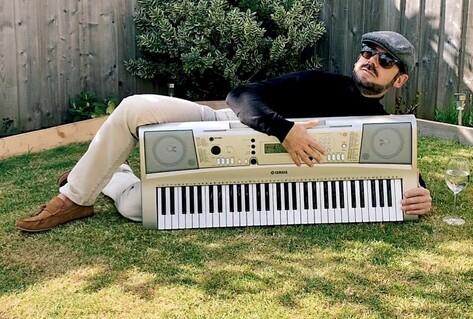
Sammy Hartstein
Sammy is 16 years old and has been a regular volunteer for the Buckfastleigh Response team, helping deliver food parcels for the food bank. He has donned his face mask and gloves and carried heavy boxes of groceries to people who needed support, often in hot weather. As well as delivering food, he has delivered books to help shielded people with their lockdown boredom. He has done all of this whilst coping with the death of his grandma, the loneliness of lockdown, and uncertainty around his GCSEs. - Nominated by Helen Hartstein
© The Royal Albert Memorial Museum

Irish Linen Centre & Lisburn Museum - "Covid 19 and Me"
Home haircut, April 2020
A three-year old boy, Oisin, has his haircut at home, Carryduff, Northern Ireland, April 2020. Due to the lockdown hairdressers were shut.
© Irish Linen Centre & Lisburn Museum

Lisburn & Castlereagh City Council staff and councillor with NHS floral banner
This floral banner, dedicated to the National Health Service (NHS), was planted by Lisburn & Castlereagh City Council staff in Lisburn’s historic 17th-century Castle Gardens.
© Lisburn & Castlereagh City Council

Shuttered shop, Lisburn City Centre, March 2020
Due to a nationwide lockdown in March 2020, shops were ordered to close. Many people were very worried by the pandemic, and shop owners often left words of encouragement on their closed businesses, including this – ‘take care and stay safe’. Lisburn Turkish Barbers is located in Market Square, Lisburn.
© Irish Linen Centre & Lisburn Museum

Child’s linen face mask
Linen is strong, lightweight, easy to work with and helps wick moisture away. It is one of the best fabrics for facemasks or coverings. In Northern Ireland, the use of face coverings in enclosed public spaces was made mandatory to help stifle the impact of the Covid-19 pandemic.
© Irish Linen Centre & Lisburn Museum

Alcohol hand sanitiser, April 2020
Alcohol hand sanitiser was in huge demand in the early days of the pandemic. Many distilleries ceased producing spirits and started selling their own, branded, hand gels. Shortcross Gin is located outside Crossgar, Co. Down, and sold their products online.
© Irish Linen Centre & Lisburn Museum

MAS & FelixArchive, Antwerp, Belgium – "Corona-archives"
Antwerp prison banners
The employees and inmates of the prison on Begijnenstraat made four banners. This way they sent out messages of solidarity and empathy - a wish for health for everybody.
15 March – 16th May 2020
Collection: MAS, inv. nr MAS.0328.002
© Employees and inmates of the Antwerp prison

Urban gym
'Beerschot Atletiek' and 'Buurtsport Kiel en Hoboken' developed a gym track across the Kiel neighbourhood. They suggest exercises everyone can do in different public places, making use of benches, stairs, etc.
20th April 2020
© Beerschot Atletiek, Buurtsport Kiel en Hoboken

Walking the Meir
When the lockdown was over, the stores on the shopping street Meir reopened. Retailers took safety measures of all kinds. The municipality created road markings to enable crowd control and ensure physical distancing.
31st March 2020
Collection: FelixArchief, inv. nr 2876#82
© Thomas Heuser

Iftar ‘on wheels’
Celebrating ‘Iftar’ — breaking the fast together after sunset — was not possible during this Ramadan. Therefore some mosques, such as El Fath, delivered Iftar meals by cargo bike to people who were alone or in poverty.
12th April – 13th May 2020
Collection: FelixArchief, inv. nr 2920#6
© Dienst Levensbeschouwingen and Mosque El Fath

’t Akkoord plays music for De Fontein
Since seniors turned out to be more vulnerable victims of the coronavirus, many inhabitants of care centres and service flats had to stay at home. The musical band ’t Akkoord gave a physical distance concert in front of residence De Fontein to provide some musical distraction.
10th May 2020
Collection: FelixArchief, inv. nr 2893#2
© Fanfare ’t Akkoord – Diana Van Strijdonck

The National Museum of Lithuania, Lithuania - “Who Will Tell the Story of COVID-19 in the Museum in the Distant Future?”
Composer Zita Bružaitė’s piece “Anxiety”
When the quarantine was announced on March 16, composer Zita Bružaitė started creating her new piece “Anxiety” (Lith. Nerimas). Every day, she devoted at least half an hour for this work. The manuscript of the composition donated by Bružaitė to the museum reflects various moods and conditions that the artist had undergone on each day of the quarantine.
© The National Museum of Lithuania

T-shirt
Spending her time at home, Gintautė focused on her favourite hobby, embroidery. Having asked her friends on Instagram what represented the current situation to them, she embroidered thirty-three different quarantine stories on her old T-shirt. The stories depict different symbolic ideas, nostalgic things, and relevant issues such as toilet paper and respirators. When a follower asked her to embroider something magical, she decided to interpret this through an image of ‘a coronavirus in a glass jar’. The T-shirt was given to the museum by Gintautė Riabovaitė.
© The National Museum of Lithuania

Cherry blossom trees online
Spring is the time when all the people of Vilnius go to the ‘sakura orchard’ to admire the blooming trees. Yet this spring, in order to protect the people and limit inevitable gatherings, Vilnius City Municipality in cooperation with the telecommunication company Telia installed cameras in the orchard and organised live web-streaming of the blooming sakura cherry trees. Vilnius City Municipality donated the informative sign to the museum.
© The National Museum of Lithuania

A ticket from Bali
In March 2020, when the borders of most of the countries were closed suddenly, travellers were faced with huge challenges. The Ministry of Foreign Affairs of the Republic of Lithuania started arranging repatriation flights from the countries with the biggest numbers of held-up registered citizens. The last flight from Bali Island took place on March 28-29. Ugnė Karaliūnaitė, who returned home on that flight, gave her tickets to the museum.
© The National Museum of Lithuania

A template for face shields
At the rapid onset and spread of this viral infection, Lithuanian health care institutions did not have enough protective equipment, whereas the acquisition of such protective gear became next to impossible. In response to the situation, the School of Robotics developed a 3D mask print template, which businesses and individuals used to print over fifty thousand face shields for health workers in a very short period of time. Paulius Briedis (VšĮ Robotikos mokykla) donated the template to the museum.
© The National Museum of Lithuania

Museum Foundation for Post and Telecommunications, Berlin, Germany - "Covid Communications"
Hamster package
This 'hamster package' was sent during the Coronavirus pandemic as an alternative birthday present, when physical visit were not possible. It contained two rolls of toilet paper, a large pack of pasta and food cans - items that were especially useful at the beginning of the first measures against the Coronavirus in Germany. Many of the items were sold out in supermarkets. The sender was the “Hamster Company, from Hamster street in Hamstern”.
Amberg, April 18th, 2020
© Margit Haberberger (Museum Foundation Post and Telecommunications)

Thank-You letter on a postcard to postmen
Deutsche Post AG received this self-designed postcard as a 'thank you' to its mail deliverers, who were particularly stressed by the increased volume of letters and parcels during the coronavirus pandemic. Because of the measures taken to combat the coronavirus, many households were increasingly having goods delivered to their homes. Since then, consignments have frequently been delivered contactlessly. The card can be seen as a gesture and sign of solidarity to the postman, similar to the evening applause for healthcare professionals. The postcard is marked with Cologne Cathedral in a snow globe.
Cologne, March 30th, 2020
© Deutsche Post (Museum Foundation Post and Telecommunications)

Diary of an extraordinary time
The book, published by the artist Hasso von Henninges, collects contributions from 20 authors who report on their daily experiences, routines and impressions from the Coronavirus period in the months of March and April. These weeks were shaped by measures to combat the coronavirus and self-isolation. They write down their thoughts partly handwritten, partly digitally. The 260-page work has a distribution run of 32 copies.
Nuremberg, March / April 2020
© Hasso von Henninges (Museum Foundation Post and Telecommunications)

Postcards in times of Corona
The artist Susanne Schattmann launched an appeal by post, sending old postcards covered with acrylic paint to family and friends, with the request to design them and send them back. More than 50 people of all ages responded with their creations. The motifs and techniques of the postcard gallery show a complete range - from watercolors and photos, to expressions and iconic representations. A related “map tour” is also being developed, as well as a self-written song.
Nuremberg, March to June 2020
© Susanne Schattmann (Museum Foundation Post and Telecommunication)

Individually created instructions for the use of Skype and IPad for seniors
The coronavirus pandemic has boosted digitization. A large part of personal exchange has increasingly shifted to digital channels due to contact restrictions. For this reason, Mr Rauch bought an iPad for his parents, who are over 80, so that he can still communicate face to face with them. Since the parents had no experience with computers, smartphones or the internet, their son created step-by-step instructions that he sent to his parents by post with the device. He explains how to use the device and instant messaging service Skype.
Dortmund, March 22nd, 2020
© C. Rauch (Museum Foundation Post and Telecommunications)
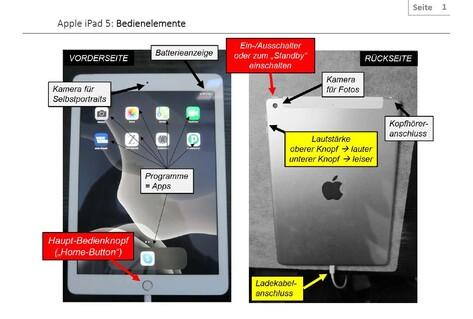
Gallery Oldham, UK - ”Oldham’s Lockdown Museum”
Tandle Hills
From busy parks, play centres and kids clubs, to open fields, long grass, sky and space. Tandle Hills has been and will continue to be our sanctuary. Children need free limitless space, time and play without the rules of the house, adults and world around them. When it was all too much this is what healed us.
© Claire Iberson

Nurses on the Children’s ward with decorated visors
Oldham’s Lockdown Museum is a digital project to collect a snapshot of what life has been like in the local area during the Covid-19 pandemic. They asked the local community to help record and explore this time, so they can share a digital time capsule with future generations of Oldham residents.
© Lucy Lees

Teddy in window
Oldham Gallery published nine digital exhibitions: Lockdown Life, Kindness, Objects, Making, Changes, Messages, Nature, Sport and Work. During August they also asked for pieces of writing — people's ‘Lockdown Letters's'
© Helen Hopkins
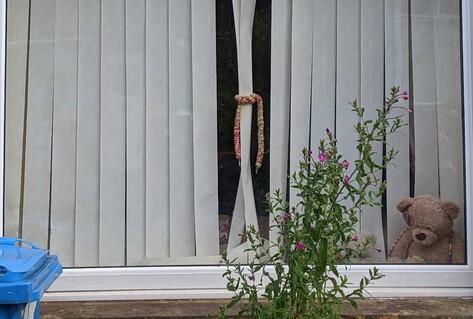
Socially distanced social occasion
So far 80 people have sent over 300 images and pieces of writing which are the beginnings of a brilliant archive which will help the Gallery tell future generations what life was like in the area during a global pandemic.
© Jane Whittaker

Jump and pose!
Child from key worker group staying active at school.
© Alexandra Park Junior School, Oldham

Liechtenstein National Museum, Liechtenstein - "Covid-19 daily life"
Corona Solidaritätsband
This bracelet was given by the Ministry of Society to the employees of the National Administration. It shows pictograms of hygiene measures, the observance of which should slow down the further spread of Covid 19.
© Liechtenstein National Museum

Border crossing point
Photo taken in the Liechtensteinsten community of Ruggell, on the border with Austria during the time when the border was closed. Translation of the sign: Border crossing point closed for all traffic (including pedestrians).
© Sven Beham

Impressions from Vaduz - "Bus stop"
Bus stop in the municipality of Vaduz: public bus, poster with information on protective measures for guests and drivers.
© Sven Beham

Impressions from Ruggell - "Posters"
Post office of the municipality of Ruggell.
On the left: Information about the limited opening hours valid from 20.04.2020. The post office was closed before.
On the right: Notice and request to keep your distance and to make cashless payments if possible.
© Sven Beham

Gesperrt Poster Gemeinde Balzers
Between mid-March and mid-May 2020, all public playgrounds and playgrounds in the Liechtenstein municipality of Balzers were closed to the public. Posters of this kind were placed at all these places.
© Liechtenstein National Museum

Historic England, UK - #PicturingLockdown
Jenny Mclean remembers Nidiya
Boundary Way Allotments are a couple of hundred yards from where I live. I went there yesterday and met a Jamaican man named Tony Mclean and we started a conversation about this project. He told me that his wife Jenny was at a funeral of her best friend Nidiya who had died of COVID-19 at that very time. I spoke with her this morning and she said she would be happy to have a chat at the allotments because she finds a lot of solace being there. She was almost physically sick when she was at her friends funeral remembering the 33 years, she was best friends with Nidiya. Black & Asian people seem to have been hardest hit with the disease in the city of Wolverhampton.
© Anand Chhabra, Wolverhampton.
Anand was one of the 10 artists commissioned by Historic England
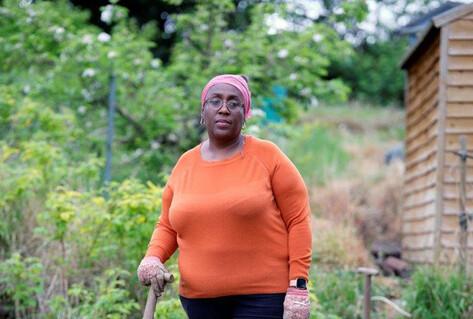
Clap for NHS
One of the project's 10 commissioned artists, Roy Mehta, picked this for including within the collection's 10 London Suburbs images. He said: "The image that I have picked is: 'Shuvaseesh Das, Clap For NHS London’. I liked some of the other images but this one encapsulates the reality of the ‘Lockdown’ for so many people. The framing enables us to see the couple in context and the clapping on the balcony can only refer to the current support for the NHS. Matched with the sombre look on their faces makes this a powerful image.
© Shuvaseesh Das, London

Socially Distanced Soaking
Back lane fun on a hot spring day. Two friends ‘fight’ til they’re wet through and their buckets are empty. Their innocent giggles and indignant shrieks reminders of days past, and of those that will come again.
© Ali Hood - Plymouth
Ali was one of nearly 3000 members of the public who submitted an image for the collection. Hers was one of 10 chosen to represent the South West.

Juliette, Juliette (sounds of the street)
As spring welcomes us with sunnier, warmer days I’ve found some of my most welcomed relief resting in the garden. A combination of Lockdown married with a furious flare of symptoms meant that this small precious outdoor space had once again become the ultimate safe haven it always is for me; a place to be in the world again only in the form of wind blowing, glorious birdsong, the chitter-chatter of children playing or my closed eyes against spring sunshine. And yet it really is a wonder to participate in such a haven of rest given that we live amongst such close quarters.
© Bella Milroy, Chesterfield, Derbyshire.
Bella was one of 10 artists commissioned by Historic England

Coincidental hair cutting
Coincidental hair cutting going on in adjacent gardens of two neighbouring families. The garden on the right belongs to staff photographer Alun Bull.
© Historic England
Photographer - Alun Bull, Sheffield
Alun is one of Historic England's resident architectural photographers

Musée de la Vie wallonne, Belgium - "Illustrating the Health Crisis"
Protection mask
This mask was designed in the context of the Covid-19 health crisis, by Isabelle Mathieu, a hat maker based in Alleur. This creation was developed to allow communication with people who are deaf, hard of hearing or mute. "Relab de Liège" collaborated on the project by providing laser cutting of the materials, ensuring that the edges of the fabric do not fray at the visor.
© Isabelle Mathieu, Province de Liège, Wallonie, Belgium
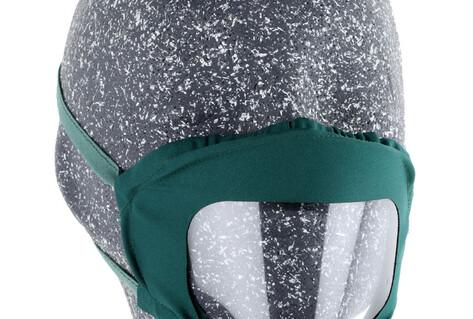
No kiss, but the heart is there!
Badge encouraging respect for physical distancing, in the context of the coronavirus crisis.
Created by Musée de la Vie wallonne, on printed metal.

Everything will be fine We promise!
Hand-crafted decorative panel conveying a message of hope, as part of the confinement imposed by the coronavirus crisis.
© Valentine Paquay

After the rain ... comes the sun, Let's stay at home!
This panel was produced during the period of confinement by a mother and her children. It was hung every day on the facade, in the windows on the ground floor of the house.
© Julie Sohier

Perth Museum & Art Gallery, Scotland - "The Local Covid Experience"
No More Skateboards
At the start of the UK lockdown at the end of March 2020, almost everything stopped. This included the usual forms of play. This is the empty skateboard park on the South Inch, Perth, Scotland.
Photo by Mark A Hall, copyright Perth Museum & Art Gallery, Culture Perth & Kinross, Perth, Scotland

Leprechauns and Rainbows
Very quickly after lockdown and the consequent home-schooling commenced, many families expressed their hopes and anxieties through playful artwork displayed in house windows.
Photo by Mark A Hall, copyright Perth Museum & Art Gallery, Culture Perth & Kinross, Perth, Scotland

Graffiti Rules OK?
From around two months into lockdown some playful protest began to emerge alongside the established empathetic response. This graffiti was created beneath the A9 bridge over the river Almond, at Inveralmond, Perth, Scotland.
Photo by Mark A Hall, copyright Perth Museum & Art Gallery, Culture Perth & Kinross, Perth, Scotland

Chalk-drawings in lockdown
During lockdown children rediscovered some traditional ways to play closer to home. These pavement chalk drawings and games cropped up in several places, in this instance the centre of Perth, Scotland.
Photo by Mark A Hall, copyright Perth Museum & Art Gallery, Culture Perth & Kinross, Perth, Scotland.

Painted Pebbles
Towards the end-phase of lockdown, children began to leave painted pebbles outside of their schools as a show of solidarity and empathy.
This is part of the so-called “family lockdown caterpillar” outside Moncrieffe Primary School, Perth, Scotland.
Photo by Mark A Hall, copyright Perth Museum & Art Gallery, Culture Perth & Kinross, Perth, Scotland

Hungarian Open Air Museum, Hungary - "Virtual Mask Exhibition"
"From Budapest"
When people started to buy all the stocks from the shops, I also wanted to provide myself proper protection, in my extraordinary way of course. I chose the medieval plague doctor mask as an example for myself. I was convinced that if that worked in the Medieval Ages, it must be useful now too. I received it just in time in April. I was doing the groceries, walking on the streets and used public transportation in this one for a week. Wherever I was, conversations froze, people were frightened around me. Professional photographers are still calling me over for having a picture on the streets. Whether there is a pandemic or not, people should never lose their senses of humour, even if it’s a bit morbid.
© Miklós Neszt
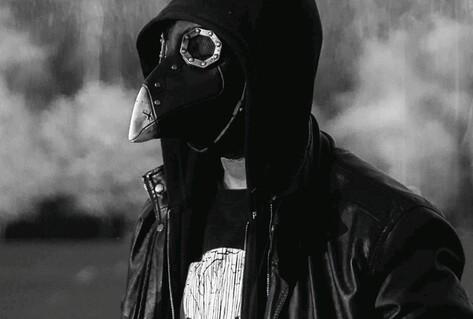
"From Mosonmagyarórvár"
It all started on the evening of 13th March, when it was announced that from next Monday we were not allowed to go to school. We all thought it will only take a week or two... we were wrong.
These masks were made of linen, we had colourful ones for the children and white ones with three layers for the others. I hope everything will be back to normal again soon. Now it is getting better, we can participate in summer camps where I can be surrounded by friends again!
© Léna Krisztina Czencz

"From Mezőkövesd"
A local dressmaker sewed my mask for my wedding. We were short on time therefore it’s not embroided. We are a family with Matyó routes, women of several generations embroided beautiful dresses and ornaments.
The wedding was on 21st March at Mezőkövesd, when my girlfriend, Beáta Görzsöny, became my wife, Beáta Kiss. :) Due to the safety measures we only had a few guests on that day, it was bizarre but also an amazing memory.
© József Kiss

"From Debrecen"
We had read in local news and on the web that the government had asked help from citizens to sew masks at home. We sent an email with our registration, received the positive answer from one of the Community Centres of Debrecen, and they delivered all the material, rubber bands and the pattern of the mask. Everything was pretty easy afterwards. My husband drew the design, my son (with reduced capacity to work) cut them and I added the required stitches at the end. We produced more than 150 masks in a few days. It was not only fun but also really useful!
© Mária Hajduné Ferenczi

"From Herend"
I am from Herend. We worked together with several helpers, sewing shops and sponsors, and voluntarily produced around 50.000 masks in Veszprém county, and gave them out for free. Most of them went to hospitals and pharmacies.
© Katalin Orbán

Museo Nacional de Antropología, Spain - "Covid Projects"
New Otherness
We asked our visitors to send us photographs with their masks on. These masks are mandatory and therefore define new faces in public spaces.
© Paloma Sánchez

Close Heritage
During the confinement phase, we asked our public to turn their house into a museum and explain their "favourite piece" in video. Alfonso told us that his hat brought back to him many memories of his country: Mexico.
© Alfonso Hernández

Anthropology for a crisis
During the confinement, more than 20 anthropologists collaborated with the museum giving some indications about what was happening and which changes in human life could be expected after this. We have published their articles on the MNA website. This picture appears in Álvaro Alconada’s “Suspended in a time of reflection”.
Written caption "Don't touch me! I could have the virus!"y
© Álvaro Alconada

Windows over the world
During the weeks in which the Spanish people were confined to their homes to avoid falling ill with Covid, their windows were their only way of seeing what was happening outside, in their street or neighbourhood. So we asked them to send us photographs of themselves. This photograph, from Ana’s window, shows us how, despite being "locked up", you can still see the rainbow. April-May 2020
© Ana Gil

New daily life
We also asked our community to send us photographs showing how they had returned to their neighbourhoods after not being able to visit them for several months. Ángel sent a photograph showing the first visit to the church in a long time.
© Ángel Villa

The National Museum of Finland, Finland - "Photo Collection"
Participants in the Poikkeusliike (‘Exceptional Moves’) community dance event in the Ruoholahti district of Helsinki, 27 March 2020. People took part in an online dance event all over Finland by dancing for 20 minutes at the same time in a place of their choice.
© Mikko Patrikainen, Finnish Heritage Agency

The Superhoitaja (‘Supernurse’) mural thanks nurses for their work during the coronavirus pandemic. The graffiti art by Molotow Finland is a mark of respect for healthcare workers and is in the Konepaja area of the Vallila district of Helsinki, 28 April 2020.
© Sakari Kiuru, Finnish Heritage Agency

Evening sing-along for residents of the Loppukiri (‘High Point’) community retirement home in the Arabianranta district of Helsinki on 19 March 2020. Residents over the age of 70 avoided physical contact during the coronavirus lockdown.
© Hannu Häkkinen, Finnish Heritage Agency

Environmental studies class in Sinebrychoff Park for Class 3B of the Helsinki German School (Deutsche Schule Helsinki), 26 May 2020. Some classes worked outdoors and some indoors when the schools reopened in mid-May. Special educational needs teacher Anmol Dogar is in the background.
© Sakari Kiuru, Finnish Heritage Agency

Despite the coronavirus, the Hurstin apu (‘Hursti Aid’) organisation distributed food to poor and disadvantaged people in the Kallio district of Helsinki, 17 April 2020. Owing to the lockdown, queuing was abandoned and food was distributed whenever people came to ask for it. The charity distributes food and clothing parcels all year round to those who need them, and it organises various events.
© Sakari Kiuru, Finnish Heritage Agency

With the emergence of the coronavirus pandemic, we at the Slovene Ethnographic Museum, as a socially responsible institution, asked ourselves how we could respond to it and, above all, how we could help people in a given situation. We decided to start collecting jokes that started circulating among us. With this, we wanted to make people happy and relieve them of everyday worries, fears and anxieties associated with illness, isolation, loneliness.
© Blaž Verbič

On the other hand, we also wanted to record the situation in society with jokes that are part of our spiritual cultural heritage. One of the jokes says that given the number of jokes circulating, there has never been a happier pandemic. Or that the jokes about the coronavirus are spreading faster than the virus itself.
© Blaž Verbič

One of the main features of jokes is oral transmission, but in a given situation, when we were forced to stay at home, everything was transferred to the Internet and modern ways of communication.
© Blaž Verbič

In two months we have collected more than 1,000 jokes and their selection is currently on display in computer projection in main museum hall and on the outside stand in front of the museum, where we write new jokes every week. For the Summer Museum Night on 20. June 2020 we are preparing an exhibition "Koronski humor".
© Blaž Verbič
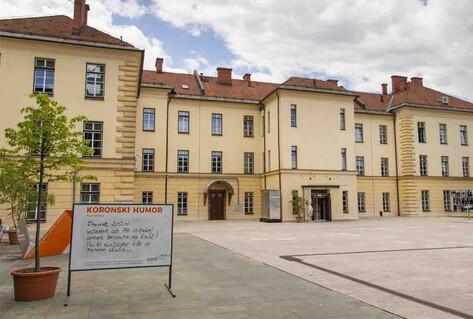
A glimpse from the exhibition CORONA HUMOUR: Jokes in time of pandemic COVID-19 ("Homeschooling versus working from home-office" section).
© Blaž Verbič

Monoghan County Museum, Republic of Ireland - “Recording Our Experience”
Sami Nasr from Co Monaghan, enjoying the cool breeze from the car window while out for a drive after lockdown eased.
© Amina Nasr

Picture of Tara McCarron from County Monaghan and a colleague working on a Covid 19 ward.
© Fiona McCarron

Picture of road in North County Monaghan during the Covid 19 lockdown.
© Angela Ovens

Picture of Glenn Murphy and family from Monaghan, who ran a marathon around his house during the lockdown and raised over €13,500 for front line workers in Monaghan.
© Glenn Murphy

Museum of Ethnography, Hungary - “Quarantine Objects”
Mask with embroidered violet
‘As a big fan of embroidery I am well aware of the time that needs to be invested; I also embroider a lot in my free time. The mask has two layers and is crafted by hand. I chose the violet to decorate it for two reasons: it is one of the first flowers that flourish in spring, exactly at the same time when the pandemic has turned up in Hungary; and on the other hand it has a symbolic meaning of rebirth and hope - for fighting against the virus.’
© Márta Halászné Magyar

Technology and Creativity
’Both my husband and I were teleworking during the confinement. I have an equally balanced and quite busy daily routine. His workload is random but the supervision is strict, his activity on screen is being checked from time to time. However, when there are no tasks to deal with — but you know that there would be a lot to do in your home — it can be infuriating. A solution has been found in the form of skewers. While I am working, the other screen also remains on. ’
Anonymous

Centrepiece
‘I love to spend my time being creative, when it comes to decorations. That creation has been made as the centrepiece for Easter. We haven’t seen our family members for weeks now and it became a daily routine to watch the updates on the virus every day on the telly. I particularly think that our days can get much better with a bit of sense of humour.’
© Nóra Veloz

Meaningful masks
‘People went extreme with buying masks as soon as the pandemic turned up in Hungary, therefore I have decided to make my own ones - it seemed the only solution. I was looking for a premium quality cotton shirt that I could produce 6 masks from the back of it.
It is a poignant picture for me because Italy is my favourite country and also had to face the virus first in Europe. There is an Italian phrase called “dare una mano” that means to give a helping hand to someone. The T-shirt has just got a missing arm, literally symbolising the missing help that Italy should have received from those countries whose tourists are basically the main customers of these goods.’
© Katalin Zubora

Ironing board
‘This ironing board has become a much greater part of our daily life in the last seven weeks than it was in the previous ten years. Its height is adjustable, therefore it is just perfect to keep the laptop on it during the online piano classes my child takes, so the teacher has a perfect view not only on the posture but on the fingers too. It was worth it to buy it for this reason alone.’
© Emőke Nagy

The National Museum of Denmark, Denmark - "Digital Artefacts on Covid-19"
Together but apart
Daughter is talking with her mother on the phone. The mother lives in a nursing home but they managed to see each other by respecting regulations and social distancing.
© Naja Christiansen

Go home
During Easter a low populated local area experienced a surge of people hiking in the nearby nature even though the guidelines in Denmark said to confine at home. A resident felt provoked by the crowding of people and made a sign saying, “Go home” and put it by the road. As her neighbours were very vexed about this, she ultimately took the sign down.
© Anne-Mette Marchen Andersen

Vesthimmerlands Museum, Denmark - “Covid Snapshot”
Birthday
Birthday without guests! Nursing homes were shut down and visitors were denied access because of the virus. That is why Grethe Gertsen’s family had to gather outside the nursing home the 2nd of April in order to celebrate her 91st birthday. She is sitting in the window.
Anonymous

Nurse
Every day the museum collects reports from people who suddenly feel that everything is turned upside down. Charlotte Høj Opheim-Winje is usually an orthopaedic surgical nurse, but in a few days, she has been retrained to manage corona patients at Farsø Hospital. Her story is now secured for future generations.
Anonymous

Netto
Before entering supermarkets and grocery stores customers are encouraged to take care of each other and the employees and keep a distance. Furthermore the stores let people know that there is no reason for hoarding, since goods are still delivered every day. Signs and warnings are an important part of our museum’s documentation of a very special situation. Later on, some of them will end up in the museum’s collection. Furthermore, the museum collaborates with the Mayor’s office in order to secure decision summaries and other important municipal documents.
Anonymous

Østerbrogade
Empty streets and towns. People stay at home, which is also an important part of the documentation the museum is currently gathering.
Anonymous

Facts
Hand sanitizer, plastic gloves and signs telling you how to behave in the supermarket, including the maximum capacity of the store. Shopping is suddenly a risky business and not at all as it used to be This is currently being documented by the museum which sees the COVID-19 crisis as a unique opportunity to document history as it is happening right now. What is really important to the museum is to depict all the changes going on.
Anonymous

La Fonderie, Belgium - “The intimate confinement”
Shopping cart
"Before", this cart was the symbol of the shopping that "had to be done" at the weekend, to the detriment of other much more attractive occupations. We dragged it a bit like a ball, and we saw in it only a utilitarian object. Now, at the time of confinement, it has become the signal for exit and adventure.
© Anne (Viroflay - France)

Clothes dryer
As my wife (the one from the shopping cart) is teleworking in our room called the office, I am confined to our living room, dining room… But our office, in the past life, served as: a piano room, a singing room, a computer room, a painting room and every 2-3 days, as a drying room. "Plume" and I now live in our dining / dryer room. I console myself because, in this time of confinement, ironing has become superfluous (…) so we aren’t also living in an ironing room!
© Christiane (Viroflay - France)

Cell phone
My cell phone has become very important since the start of confinement because I was able to call my family, my friends ... Thanks to the cell phone, I am also in contact with my teacher. I broke my old phone the weekend before the confinement started, and I was able to buy another at the very last minute, on Wednesday when all the stores were to close at noon. I arrived at the store at 11am. Phew!
© Louane (Anderlecht - Belgium)

National Museum of Contemporary Art, Romania - “UNARTE Quarantine Artistic Laboratory”
Trap 2020 / I'm not present 2020
“Even though the house of my parents is much bigger than the studio I lived in Bucharest before the quarantine, I feel like I’m in one of those big cages at the zoo, where the animal gets to live in conditions that replicate its natural habitat, but it is still missing freedom.”
© Teodora Savu (b. 1996), student at UNARTE - Graphic Arts Section, second year, Master, after priorly graduating her BA in Scenography

Home is everywhere project: There Is No Outside, 2020 / We'll Call You, 2020
"Unfortunately, the situation forces me to keep my apartment as my only «home». By drawing I can escape a little and place myself in different spaces that have a familiar atmosphere. Although the state I am conveying is one of loneliness and boredom, I consider it a very beneficial period for artistic development and beyond.”
© Mălina Lorelei Fulga (n. 1998), a student at UNARTE - Graphic Design Department, third year, BA level.

Self-isolation diary, fragment, 2020
"The «What day is it» series is a short self-isolation diary that illustrates my personal process of adaptation in the midst of a pandemic for almost a month. It started as a university assignment and turned out to be one of the most therapeutic activities I've done during these months.
The diary consists of two parts: the first part answers the «Where am I?» question and mainly reflects the psychological changes produced by the new and much-too-different reality between the four walls where we got stuck overnight. The second is about «Where would I like to be?» and nostalgically illustrates the small, once common desires that keep invading our thoughts during these times."
Diana Grigore (b. 1997), a student at UNARTE - Department of Object Design and Visual Communications Department, first year, MA level

